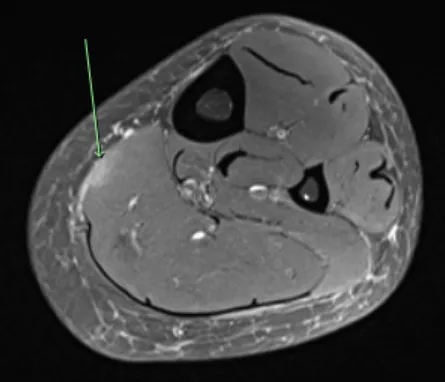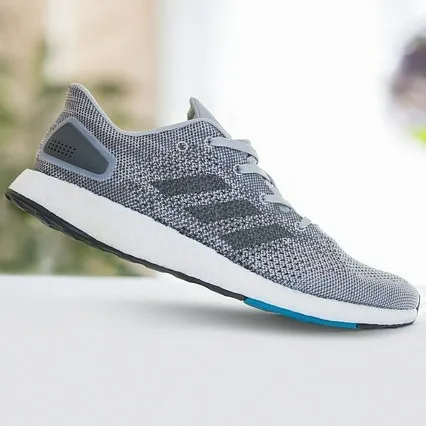In This Article
A calf muscle strain is a mild injury, often without any damage or tear. It affects either or both of the calf muscles, Soleus and Gastrocnemius. It can feel like tightness, aching or a pulling sensation.
A “strain” is not a medical classification but refers to mild muscle injuries. It is roughly equivalent to a Grade 1 or low Grade 2 muscle injury. (There are three grades of muscle injury, Grade 3 being the most severe).

Calf muscle strains are most common after a running activity, including football, basketball or running itself. It can present as a sudden stabbing pain although it’s more commonly felt as a gradually worsening tightness.

Need a running shoe to help ease calf pain?
Our Physio experts have listed the key shoe features to look for if you’ve got calf pain, including recommended brands and models.
TIPS FOR FIXING A CALF MUSCLE STRAIN QUICKLY
- The most commonly injured muscle in the calf is the Soleus
- The Soleus muscle is the deeper (closer to the bone) of the two calf muscles
- It’s function is to brace the ankle (hold it rigid) on landing
- This bracing action protects the ankle joint and allows the Achilles tendon can store elastic energy
- Calf circumference measurements can be useful to track swelling and bleeding in this injury
- Measure the calf muscle while relaxed and lying prone (on your stomach)
- Find the largest measurement with a cloth tape measure
- Compare sides:
- Differences of <1cm are unlikely to be relevant
- If the injured side is larger by 1cm or more, this may indicate an accumulation of swelling or bleeding. This may indicate a Calf muscle tear instead of a strain
- Add a heel wedge (like this example) to your regular shoes or wearing shoes with a medium (5-8cm) broad heel
- This is helpful in the early weeks as it reduces the stretch and pressure on the muscle
- However a narrow heel or unstable shoe can cause the muscle to become more active. This would have the opposite effect
- Select a shoe with a broad stable heel, such as a wedge or block heel
- Massage can be helpful at managing symptoms during rehab
- It can be helpful in the early phase in relieving muscle soreness and aching
- As rehab progresses, massage can be used to relieve the feeling of tightness and fatigue
- Massage should be gentle in the early phase and can gradually increase in pressure over the weeks
- Massage shouldn’t be used if a tear is suspected or with an increased calf circumference (see point above)
AVOID THESE MISTAKES WHEN TREATING YOUR CALF STRAIN
- Calf raises (aka Heel raises) a common calf muscle exercise, are rather ineffective for rehab of calf muscle injuries
- The main role of the most commonly injured muscle is to brace the ankle, not push you up on your toes
- Movement is too slow to train the muscle for rapid propulsion
- The loading is insufficient to adequately rehab a calf strain
- Stretching a recently torn muscle is counterproductive
- Stretching may overload the healing tissue and delay recovery
- It doesn’t offer any benefits for muscle length or tissue tolerance
- Strength exercises alone are insufficient to prepare for a return to running sports
- The calf muscles rapidly generate forces up to 8x body weight
- They need both heavier loads and faster movements to be ready for running
- Following on from strength training, a full return to play program should incorporate aspects of calf function including sprinting and slowing down quickly
WHAT ELSE COULD IT BE?
As a calf muscle strain can come on gradually and without an obvious cause, it’s important to consider other diagnoses that have a similar presentation.
- If it’s a deep constant ache, it could be a Tibial Stress Fracture
- Consider this to be more likely if the ache is present without weight on the leg and it lasts for >24 hours after exercise
- When there’s a concurrent knee injury with knee swelling, you may have a ruptured Baker’s Cyst
- This injury can present as an increasing ache in the calf without obvious cause
- On calf circumference measurement (see point above in Tips), the calf will be significantly larger on the affected side
- If it’s a vague pain that extends further up the leg, it may be Sciatica
- Sciatica doesn’t have to cover the whole leg and may just present with calf pain
- However, if your calf pain begins to extend above the knee or below the ankle, suspect the Sciatic nerve as a potential cause
